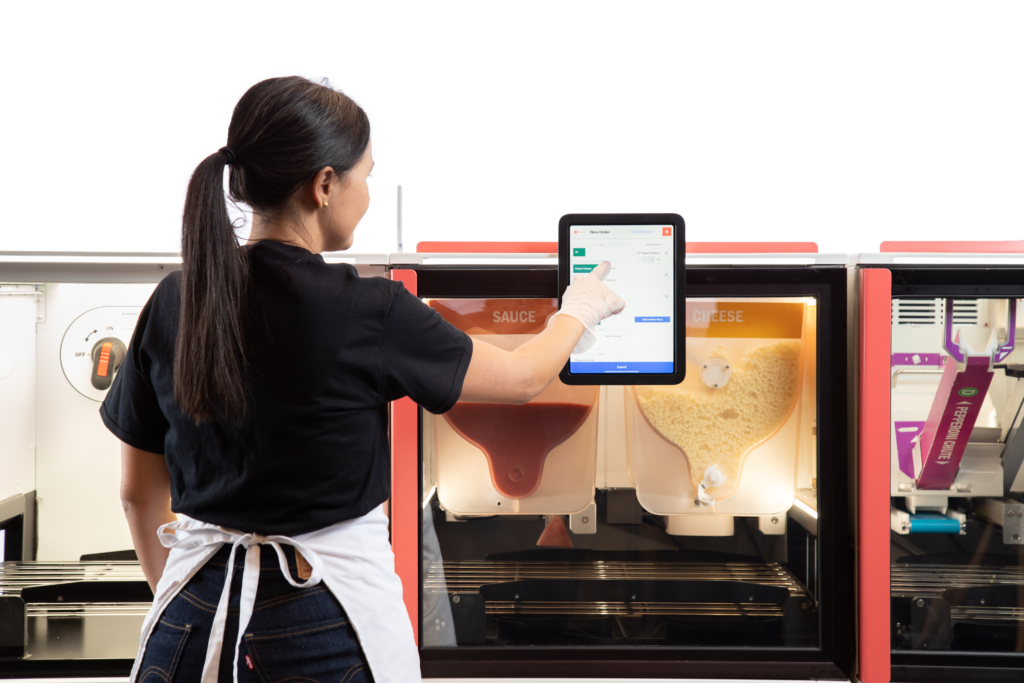Published December 22, 2021

Have you been to a restaurant lately that didn’t have a help wanted sign in the window? Restaurants and kitchens of all sizes are facing a massive labor shortage, which is impacting their ability to remain open, maintain quality and offer great customer service. When kitchen owners can find employees, they are having to pay them more, which is impacting profits. Since it’s unclear when this labor shortage will end, kitchens are increasingly bringing in automation and robotics to help prepare food.
This is where Picnic comes in. Our Picnic Pizza Station, a configurable automated pizza assembly system, is finding tremendous success with kitchens and restaurants that serve pizza. But one thing that is really helping Picnic thrive, (our secret sauce, so to speak) is not just employing robotics and automation experts, but a deep investment in food engineers. We know that unless the pizza is topped to perfection, looks and smells delicious, and has wonderful mouthfeel, automation can’t effectively deliver against its promise. And that requires food engineering.
Meet Dr. Gabriella Mendes, who has joined Picnic as Senior Food Scientist. Gabriella grew up in Brazil and was fascinated with food from an early age. She says food engineering is a multidisciplinary field that combines principles of engineering applied to food science to study the composition, processing, conservation, deterioration, elaboration, quality, and commercialization of food.
Food engineers have skills in chemistry, biochemistry, nutrition, and microbiology, and they apply those skills to all facets of food production. Gabriella makes sure that not only can our automated system prepare food, but that the food is safe to eat, has great mouthfeel, and is nutritious and delicious.
“ Gabriella makes sure that not only can our automated system prepare food, but that the food is safe to eat, has great mouthfeel, and is nutritious and delicious.”
Growing up on a farm, Gabriella loved to watch her mother make cheese, butter, yogurt, and ice cream from scratch using milk from the cows surrounding the grounds of her native home. She has always been fascinated with the process and became even more curious about food preparation, food safety, and quality.
As she grew, she realized her passions for chemistry, biology, and physics could be applicable to a career in food engineering. She went on to pursue a Food Engineering “Ph.D.” at Purdue University in Indiana and did her post-doctoral while working at the USDA where she oversaw multiple projects to support food safety, quality assurance, and pathogen reduction.

At Picnic, Gabriella ensures that the approach to robotics and automation development also factors in how ingredients and production of the food will result in a perfect and delicious pizza every time. Other food robotic and automation companies are focused on the machine engineering, where at Picnic, food science and engineering are always treated with equal importance.
The Picnic Pizza Station uses ingredients like cheese, sauce, and meats and vegetables to top pizzas. Ensuring the system can handle these different types of ingredients, while maintaining top quality, wonderful visual impact, and delicious taste requires a lot of partnership from the automation engineers and the food engineers.
In her daily work, Gabriella practices both food science and food engineering. For example, as a food scientist, she tests sauce for viscosity and sample toppings for pH to recommend optimal ingredient characteristics. As a food engineer, she comes up with ideas to design better mechanical systems for the toppings modules and works with our mechanical engineers to bring them to life.

Gabriella’s favorite afternoon snack is Pao-de-queijo, a Brazilian cheese bread. But her favorite cuisine is Italian, including pasta, lasagna, and especially pizza! Her favorite pizza is Chicken Alfredo.
When asked the highly controversial question about whether pineapple should ever be included on a pizza, she said, “absolutely yes!” She loves how the sweet flavor of the pineapple complements salty toppings like ham or bacon.
“ The goal at Picnic is to be the essential back-of-house makeline that transforms the future of food preparation through robotic automation and human innovation.”
The goal at Picnic is to be the essential back-of-house makeline that transforms the future of food preparation through robotic automation and human innovation. Gabriella and the food science team help ensure restaurant owners and their customers love the pizzas that the Picnic Pizza Station makes.